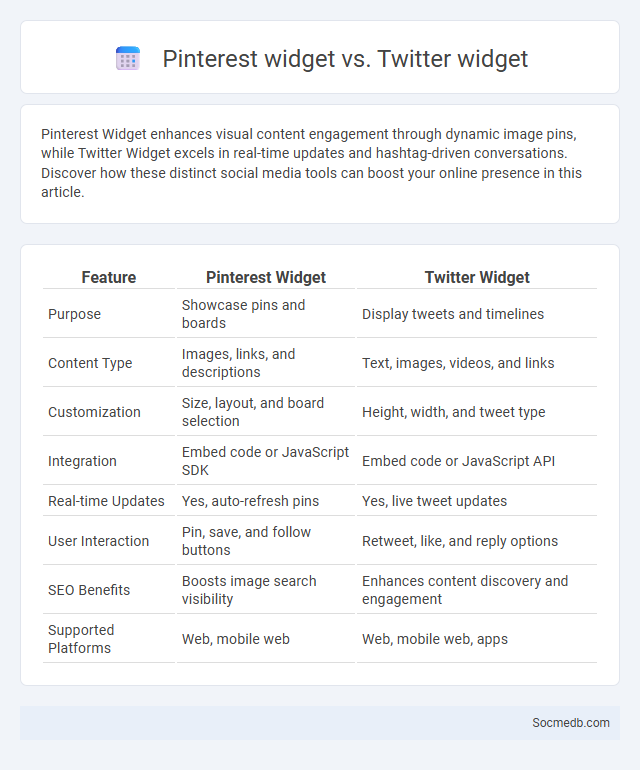
Photo illustration: Pinterest Widget vs Twitter Widget
Pinterest Widget enhances visual content engagement through dynamic image pins, while Twitter Widget excels in real-time updates and hashtag-driven conversations. Discover how these distinct social media tools can boost your online presence in this article.
Table of Comparison
| Feature | Pinterest Widget | Twitter Widget |
|---|---|---|
| Purpose | Showcase pins and boards | Display tweets and timelines |
| Content Type | Images, links, and descriptions | Text, images, videos, and links |
| Customization | Size, layout, and board selection | Height, width, and tweet type |
| Integration | Embed code or JavaScript SDK | Embed code or JavaScript API |
| Real-time Updates | Yes, auto-refresh pins | Yes, live tweet updates |
| User Interaction | Pin, save, and follow buttons | Retweet, like, and reply options |
| SEO Benefits | Boosts image search visibility | Enhances content discovery and engagement |
| Supported Platforms | Web, mobile web | Web, mobile web, apps |
Introduction to Widgets: Pinterest, Twitter, and General Widgets
Widgets like Pinterest, Twitter, and general social media tools enhance your website's interactivity by embedding real-time content feeds, user engagement buttons, and sharing options. Pinterest widgets allow you to showcase visual inspiration, while Twitter widgets display live tweets and trending topics to keep your audience informed. These interactive elements boost user experience and drive more traffic by seamlessly integrating social platforms into your digital presence.
Key Features Overview: Pinterest Widget
Pinterest Widget offers seamless integration for websites, allowing users to showcase pins directly on their pages with dynamic content updates. It supports customizable layouts and real-time pin display, enhancing user engagement through visually appealing and organized boards. The widget also provides easy sharing options and links back to Pinterest profiles, driving traffic and fostering community interaction.
Key Features Overview: Twitter Widget
The Twitter Widget offers seamless integration of real-time tweets into websites, enhancing user engagement through live social media feeds. Customizable options include timeline styles, tweet limit, and display of user profile images or hashtags, ensuring tailored content presentation. Responsive design guarantees optimal performance across all devices, boosting interactivity and social proof for brands or influencers.
Widget: General Characteristics and Functionality
Social media widgets are interactive components embedded on websites and applications to enhance user engagement and facilitate content sharing. These widgets commonly feature functionalities such as live feeds, like and share buttons, comment sections, and user authentication modules, providing seamless integration with major platforms like Facebook, Twitter, and Instagram. Their general characteristics include real-time updates, customizable design, and compatibility across devices, which contribute to increasing audience reach and improving user experience.
Customization Options: Pinterest vs Twitter vs Generic Widgets
Pinterest offers extensive customization options with visually rich pins and boards that allow you to tailor content to niche interests, enhancing user engagement through personalized feeds. Twitter provides real-time content customization features like topic follows and curated moments but has limited widget flexibility compared to Pinterest. Generic widgets deliver basic social media integration but lack the advanced customization and tailored content capabilities that Pinterest and Twitter offer to optimize Your social media presence.
Integration and Compatibility: Platform Support Comparison
Social media platforms vary significantly in integration and compatibility features, impacting user experience and cross-platform functionality. Facebook, Instagram, and Twitter offer robust APIs and third-party app support, facilitating seamless content sharing and synchronization across devices. TikTok and Snapchat prioritize mobile optimization but provide limited integration with external tools compared to LinkedIn, which excels in professional software compatibility and enterprise-level integrations.
User Engagement: Pinterest vs Twitter Widgets
Pinterest widgets drive higher user engagement by showcasing visually appealing pins that encourage longer interaction times and increased click-through rates compared to Twitter widgets. Twitter widgets primarily deliver real-time updates and brief interactions, which often result in lower user retention but timely content dissemination. Brands leveraging Pinterest widgets benefit from richer content discovery and stronger user interest, while Twitter widgets excel in quick information sharing and immediate audience response.
Analytics and Performance Tracking
Social media analytics tools provide in-depth insights into audience behavior, engagement rates, and content reach, enabling marketers to refine their strategies effectively. Performance tracking metrics such as click-through rates (CTR), conversion rates, and follower growth offer measurable data to assess campaign impact and ROI. Leveraging platforms like Facebook Insights, Twitter Analytics, and Instagram Insights can optimize social media efforts by identifying trends and improving content relevance.
Pros and Cons: Pinterest Widget, Twitter Widget, and Generic Widget
Pinterest Widget enhances user engagement by visually showcasing pins, driving traffic through compelling images, but it can slow page load times and may not update in real-time. Twitter Widget offers real-time updates and boosts social interaction with live tweets, yet it can clutter page design and sometimes suffers from API limitations. Generic Widgets provide versatile social media integration across platforms, allowing customization, but may lack platform-specific features and require manual setup for full functionality.
Choosing the Best Widget for Your Website
Selecting the best social media widget for your website depends on factors like platform compatibility, user engagement features, and customizable design options. Widgets such as Facebook Like Buttons, Twitter Feed displays, and Instagram Galleries enhance visitor interaction and boost brand visibility. Evaluating load speed and mobile responsiveness ensures seamless integration and improved user experience across devices.
 socmedb.com
socmedb.com